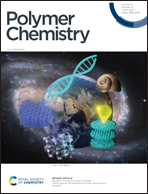Preparation of thermostable and compatible citrate-based polyesters for enhancing the ultraviolet shielding performance of thermoplastic resin†
Abstract
In this study, a new class of citrate-based polyesters (CPs) with excellent UV (ultraviolet) absorption characteristics was designed and synthesized from a series of diols and a derivative of citric acid and cysteine (thiazolopyridine dicarboxylic acid, TPDA). The as-prepared CPs enhanced the UV shielding performances of a widely used thermoplastic resin, poly(ethylene terephthalate-co-1,4-cylclohexylenedimethylene terephthalate) (PETG) when incorporated through physical blending. The results revealed that TPDA endowed the CPs with high UV absorption efficiency, and the polymeric state endowed the CPs with excellent thermal stability. Moreover, these CPs exhibited good compatibility with PETG due to similarities in their chemical structures. The UV shielding performances, mechanical properties, and stability of CP/PETG blends were also investigated. The data indicated that the 2% addition of CPs endowed the CP/PETG blends with full-band UV shielding performance; however, the thermal stability and mechanical properties of PETG remained unaffected. In summary, the green synthetic approach of TPDA combined with the advantages of CPs makes the as-prepared biobased polymeric UV absorbers very promising for future UV shielding applications.



 Please wait while we load your content...
Please wait while we load your content...